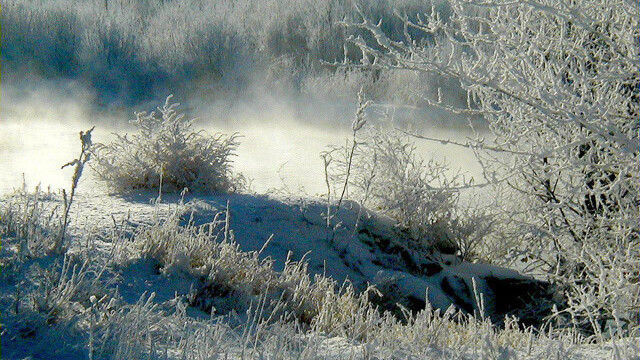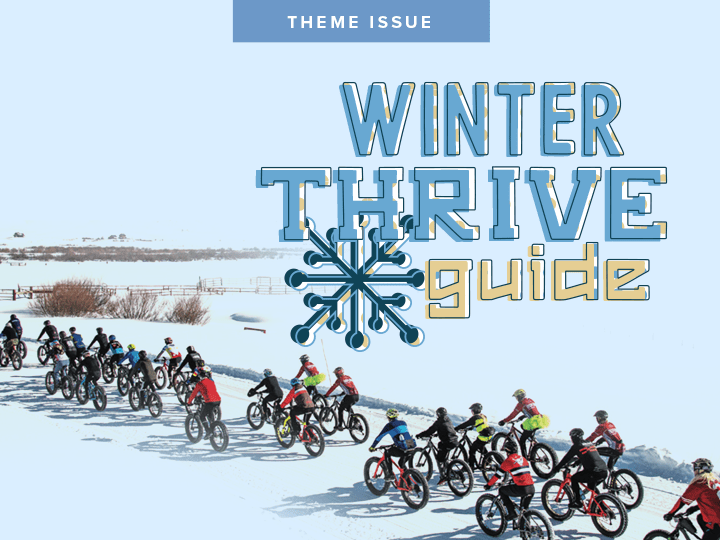Coldstruck: Smitten by the River in Winter

It was the steam, every morning, that slowed my steps.
A hundred separate tufts of steam would be in flux across the backbone of the river, quietly describing the air’s depth. They rose to dramatic heights – up to bridge level – and swerved horizontally at their bases like crazed tornadoes. On especially windy days, the steam skated around in a homogenous mass, vapor replacing itself as fast as it was dispersed. Anchored above the horizon was the blinding sun. The bars of the bridge railing created a strobe light effect as I walked, adding visual shock to breathtaking cold.
I came to anticipate my bridge walk in winter more than I thought possible. The “brutal” bridge had always been common ground – literally, but also figuratively. A space of mutual complaint. The epitome of winter’s chokehold. Something you might be forced to do if your car didn’t start. A chip to place on the table when commiserating with fellow northern dwellers. So it surprised me when I found myself walking more and more slowly across the bridge, until one day I just stopped and gaped.
There was a sense that what I was viewing rarely happened, was rarely appreciated. I seldom saw another person. And I watched this other-worldliness through the porthole of a closely drawn hood. Outside my coat, everything was secretive and strange so that I felt as if I didn’t really belong. But the rarity wasn’t just a feeling; I learned that conditions for a cold steamy river resided in the crescent of overlap in a wintry Venn diagram of sorts.
On days below 20 degrees, at 8:25, my on-foot commute was perfectly timed to view the vapor starting to ghost off the surface of the water. If I’d needed to get to work earlier, the river would still be chilled; the surface not yet warmed enough to begin its pattern of evaporation and condensation. Too late and it had all burned off – the river’s temperature consistent with the air above it, at least to the depth of a finger.
Below the whitish haze was the river’s surface. Surface implies uniformity, but the Chippewa in winter is not totally frozen and not totally flowing. Within the stream of exposed water between temporary “banks,” geometric panes of ice would float, having broken off from their mother landmasses, their edges catching and reattaching like accelerated plate tectonics. The river’s currents are best illustrated by what rides in them: trapezoids of ice would spin endlessly in the stubborn eddies. When the ice held a layer of snow, small animal prints appeared, sharp and traceable at first, softening into anonymity after a snowfall. A lone fish once trapped itself on the river’s solid top, jumping unthinkingly out.
And there was the Great Ice Crash of 2009, when the entire river froze to a foot-and-a-half thick and then broke. Great heavy slabs upended and crash-landed on shore. The river had never (to my memory) looked so much like the aftermath of an earthquake. When I got closer to the giants, I found their cross sections to be translucent, ethereal blue and holding tiny air bubbles. I didn’t care that my fingers almost froze to the shutter button on my camera.
I say these things because winter doesn’t get enough credit for its dynamism. It’s seen as frozen and stagnant, unmoving until the thaw. And perhaps summer gets too much. In the summertime, the river stays consistent and predictable, flowing indefinitely. It is liquid from top to stone-studded bottom. One state of matter – no chance of steam, no crackling ice. The banks themselves don’t expand or contract, unless a minor flood occurs – which, incidentally, is the most interesting thing that can happen. Sure, it’s nice to be in a tube or a canoe, but if I were to paint a scene, I’d paint the winter river. There are so many different shades of white.

